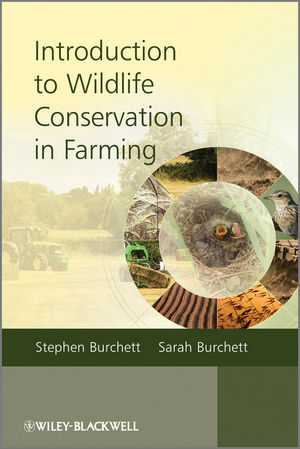Introduction to Wildlife Conservation in FarmingISBN: 978-0-470-69935-5
Hardcover
326 pages
December 2010
 Other Available Formats: Paperback
|
||||||
Acknowledgements.
1 Introduction.
1.1 Conservation on farmland – why?
Species Box 1.1: Starfruit Plant (Damasonium alisma).
1.2 Historical relevance of on-farm conservation.
1.3 Legislation and policy.
1.4 Impact of agricultural policy on the environment.
1.5 Further afield.
References.
2 Mixed farming.
2.1 Introduction.
2.2 Conventional cereal crop production.
2.3 Life cycle.
2.4 Crop establishment.
2.5 Nutrient requirements.
2.6 Disease and pest control.
2.7 Weed control.
2.8 Harvest and crop quality criteria.
2.9 Organic agriculture.
2.10 Organic conversion.
2.11 Soil fertility and crop rotations.
2.12 Summary.
Case Study 2.1: Down Farm.
Species Box 2.1: Cirl Bunting (Emberiza cirlus).
Species Box 2.2: Skylark (Alauda arvensis).
Species Box 2.3: Corn Marigold (Chrysanthemum segetum).
2.13 Arable Flora.
Species Box 2.4: Night-Flowering Catchfly (Silene noctiflora) and Small-Flowered Catchfly (Silene gallica).
2.14 Elveden estate.
Species Box 2.5: Stone Curlew (Burhinus oedicnemus).
Case Study 2.2: STEEP Programme in the Pacific North West.
Case Study 2.3: Cholderton Estate.
Case Study 2.4: Blueberry Hill Farm, Maryland, US.
2.15 Chapter summary.
References.
3 Grasslands.
3.1 Introduction.
3.2 Cultivated grasslands for grazing domestic stock.
3.3 Breed selection.
3.4 Making more of native grasslands.
Case Study 3.1: Prairies.
Species Box 3.1: Prairie Chicken (Tympanicus cupidus).
Species Box 3.2: Pronghorn (Antilocapra americana).
Case Study 3.2: Switchgrass (Panicum virgatum).
Species Box 3.3: Golden Plover (Pluvialis apricaria).
Species Box 3.4: Lapwing (Vanellus vanellus) – Also Known as the Peewit.
Case Study 3.3: UK Uplands.
Species Box 3.5: Bee Orchid (Ophrys apifera).
3.5 Grassland ecosystems around the world.
3.6 Temperate grasslands.
Case Study 3.4: Sheltering Rock-Tuckaway Farm.
Species Box 3.6: Plains Wanderer (Pedionomus torquatus).
References.
4 Forestry and conservation.
4.1 Introduction.
4.2 Forest management.
4.3 Forest management techniques: the UK model.
4.4 Coppice.
4.5 Coppice and wildlife.
4.6 Wood pasture.
4.7 Commercial forestry.
4.8 High forest.
4.9 Planting.
4.10 Harvesting.
4.11 Sustainable forest management.
Case Study 4.1: Sunart Oakwoods Initiative.
Species Box 4.1: Red Squirrel (Sciurus vulgaris).
Case Study 4.2: Longleaf Pine.
Species Box 4.2: Long Leaf Pine (Pinus palustris).
Species Box 4.3: Red Cockaded Woodpecker (Picoides boralis).
Species Box 4.4: Fox Squirrel (Sciurus niger).
Case Study 4.3: New Hampshire Woodlands.
Case Study 4.4: Malaysian Tropical Forests, Forestry Industry and Enrichment Planting.
Species Box 4.5: Dipterocarpaceae.
Species Box 4.6: Bornean Clouded Leopard (Neofelis diardi ssp. borneensis).
4.12 Summary.
References.
5 Farming and the aquatic environment.
5.1 Water.
5.2 Water framework directive.
5.3 Part 1: On farm ponds, watercourses and riparian strips.
Species Box 5.1: Curlew (Numenius arquata).
Case Study 5.1: Kuenzler Farm Wetland Restoration Programme.
Species Box 5.2: Bob White Quail (Colinus virginianus).
Species Box 5.3: Northern Cricket Frog (Acris crepitans).
5.4 Part 2: Fens, marshes and wetlands.
Species Box 5.4: Large Copper Butterfly (Lycaena dispar).
Species Box 5.5: European Bittern (Botaurus stellaris).
5.5 Part 3: Estuaries, coastal and marine.
Species Box 5.6: Natterjack Toad (Epidalia calamita–Formally Bufo calamita).
5.6 Part 4: Aquaculture/fish farming.
Case Study 5.2: Dragon Feeds Ltd.
Case Study 5.3: Loch Duart Ltd Scotland.
Case Study 5.4: Offshore Fisheries in New Hampshire, US.
References.
6 The future of farming and its implications for conservation.
6.1 Introduction.
6.2 Industrial-scale farming and monocultures.
6.3 Science and technology.
6.4 Precision farming.
6.5 Biotechnology.
6.6 Tissue culture.
6.7 Implications of reduced crop and stock diversity.
6.8 Subsistence farming and emerging economies.
6.9 Sustainable use of water, energy and waste.
6.10 Agri-environment schemes.
6.11 Conclusion.
References.
Acronym list.
Species tables.
Glossary.
Index.



